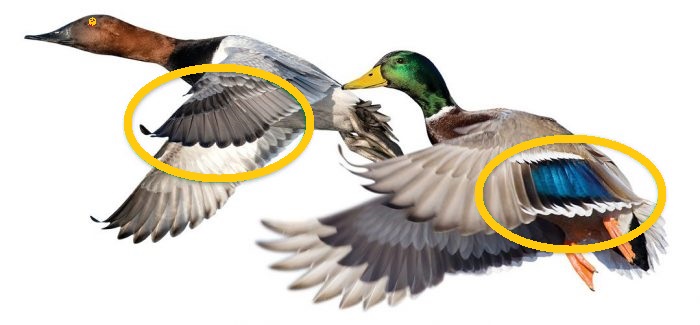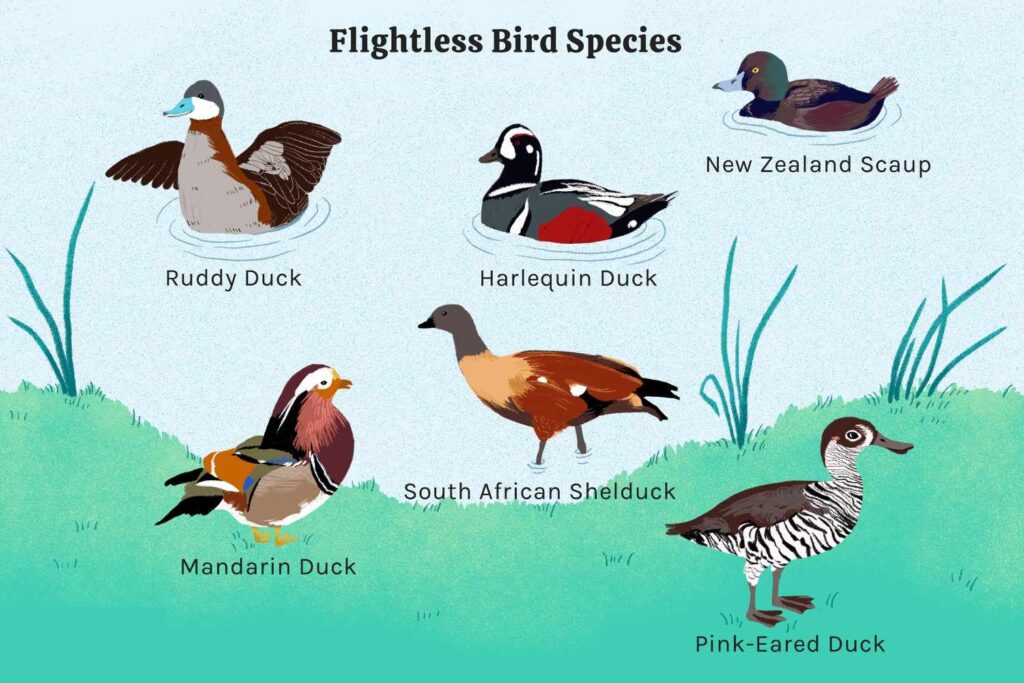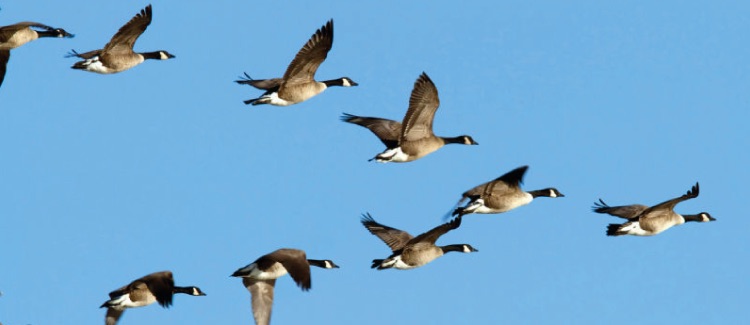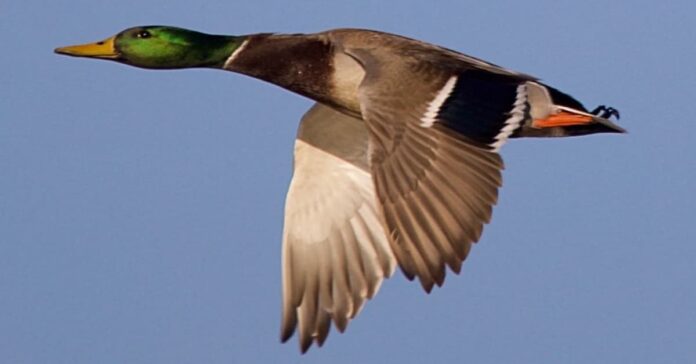Can ducks fly you ask. Ducks can fly far away to new places, which is called migration. They have special parts like strong wings and muscles that help them fly and special feathers that make their flying smooth. It’s fun to watch ducks fly and see how they travel so far. We must take care of their homes so that the ducks can eat and during their trip.
Ducks can fly long distances to find warmer places during the winter. They use special ways to fly efficiently, like using strong muscles and special feathers to fly smoothly. These special ways help them travel far from their homes in Canada to places where it’s warmer.
Ducks must go on a long journeys to find warm places during winter. They can fly very far, even thousands of kilometers, without taking a break. Some ducks fly from Canada to South America, while others fly from the Arctic to Alaska or Canada. It’s incredible how far they can fly!
“Have you ever looked up and marveled at a duck soaring through the sky and wondered how it’s able to travel such far distances? This is all due to the unique physical characteristics that assist them in flying and enduring their long travels. Let’s dive into the exciting world of ducks and learn all about their amazing abilities!”
About Duck Wings
- Ducks have small wings, so they can’t fly like big birds like hawks. Instead, they have to flap their wings about 10 times a second to keep their bodies up in the air. Their wings are shaped like a pointy arrow, like the fastest bird on Earth, the peregrine falcon. With this special wing shape and fast flapping, ducks can fly about 80 kilometers per hour!
- Ducks have special wings that help them fly long distances. They have to flap their wings very fast to stay in the air. Different types of ducks have differently shaped wings that help them fly in different ways. Some ducks have shorter and wider wings that help them fly around trees and plants in wetland areas. Others have longer wings that help them fly over open water. Even though they are not as elegant as some other birds, they can still fly up to 80 kilometers per hour!
- Ducks have special feathers on their wings that help them fly. These feathers are shaped differently on the top and bottom, overlapping to make the wing curved and pointed. This special shape, along with the strong muscles ducks have in their wings, allows them to fly fast and far, like when they migrate to warm places in the winter. But, because of their wing shape, ducks aren’t very good at making quick turns like other birds.
Fact To Know
Ducks and geese have muscles that control their feathers, which they use for staying warm, diving underwater, and expressing emotions such as anger or love. They have as many as 12,000 of these special muscles!
Duck Feathers Mechanism When They Fly
Ducks have specialized feathers on their wings that aid them in flying. These feathers, called primary feathers, can be found at the tips of their wings. They are long and sturdy and play a crucial role in helping the duck take flight.
Without these feathers, a duck would be unable to fly, as some birds have had their primary feathers trimmed. Additionally, the tips of these feathers are dark in color, providing added protection against wear and tear.

The secondary feathers are shorter flight feathers that are attached to the duck’s “forearm” bone and situated near the primary feathers. Together with the primary feathers, they form the speculum – a colorful part of the duck’s wing that can appear in shades of green, blue, purple, or white.
When a duck flaps its wings, the primary feathers spread out to allow air to pass through, while the secondary feathers push air upwards, providing lift for the bird.
Wing coverts are feathers covering the base of the primary and secondary feathers on both sides. They make the wing smooth so that the duck can fly better. Some ducks have different colored wing coverts, like the blue-winged teal, which has a blue patch on its wing.
Tail feathers help ducks control the direction of their flight, like the steering wheel on a car. They make sure the duck goes where it wants to go, just like a rudder on a boat helps steer the boat.
Ducks have large bodies and small wings, which can make it challenging for them to fly slowly. To address this issue, they have a feature called a winglet or alula, which is a group of feathers attached to the equivalent of a human thumb. This winglet helps create a smoother wing surface and reduces flight speed, making it easier for ducks to land safely.
Habitat matters, too!
Ducks have special feathers that help them fly, but they also need our help to make sure they have a place to live and enough food to eat. We must work together to protect their homes and ensure they have everything they need to survive.
ALSO READ: Do Ducks Mate For Life? (Complete Guide)
Can Ducks Fly? Key Points
- Ducks can fly really fast and are really good at flying.
- Mallards are a type of wild duck that can fly really well.
- Domestic ducks are different from wild ducks because they can’t fly. They have been bred not to have the ability to fly so they can stay close to home.
“Hey kids, did you know that there are more than 100 different types of ducks in the world? Some ducks can fly really well and go really fast and far, while others can’t fly at all. Do you want to learn more about different types of ducks and how they can fly? Keep reading to find out!”
Can Ducks Fly?
Some ducks can fly while others cannot. For example, the Muscovy duck and the Khaki Campbell duck can fly, while the Pekin duck, Rouen duck, and Cayuga duck cannot fly.
Why Are Some Ducks Unable to Fly?

Not all ducks can fly. Some ducks, such as Pekin ducks, are too heavy or have been bred to be large and heavy, making it difficult for them to fly. If they do manage to take off, they won’t be able to fly as far or as high as wild ducks like mallards.
Ducks can fly differently, depending on their body weight and wing size. Some ducks, such as Pekin and Cayuga, are bred and kept by humans in captivity and do not need to fly to migrate to warmer areas like wild ducks. While you may observe these ducks flapping their wings and moving around on the ground, they cannot fly as effectively as wild ducks.
Types of Ducks?
Ducks can be grouped into three categories: diving, dabbling, and domestic.
Ducks can be categorized based on their behaviors into different groups. One such group is called diving ducks. These ducks enjoy swimming on the surface of water bodies such as lakes or ponds and diving deep to search for food.
Some common types of diving ducks are the Pochard and Scaup. They earned their name due to their habit of diving underwater to find food.
Diving ducks differ from other ducks because they swim deep in the water to find food. They have strong legs and webbed feet that make it easier for them to swim. They can stay underwater for a while and have ways to hold their breath while down there. Pochard and Scaup are two examples of diving ducks.
Dabbling ducks are a type of duck that likes to eat food on the surface of the water or just briefly dip their head under. They don’t go underwater as diving ducks do. Some examples of dabbling ducks are Mallards, Northern Pintails, and American Black Ducks. You might see them at a local pond or lake.
Domestic ducks are a type of duck not found in the wild but raised by humans, usually on farms. Unlike wild ducks such as Mallards or Pintails, domestic ducks are bred and kept in captivity. Examples of domestic ducks include the Pekin and Cayuga, with some raised for meat and others kept as farm pets.
When you encounter a domestic duck, it is important to remember that this type of duck is not found in the wild but is raised by humans for various purposes, such as for food or as pets.
They are often kept on farms or ranches and come from a lineage that includes Muscovy or mallard ducks. Additionally, domestic ducks living on farms or ranches may mate with wild ducks that come to nearby bodies of water, creating unique hybrid duck breeds.
How Are Ducks Able to Fly?
Some ducks like to travel a lot! The king eider is famous for its long trip of 10,000km from Alaska or Canada to the Arctic. The blue-winged teal is also a great traveler; it can fly more than 6,000km from Canada to Peru in South America!
Ducks are capable of flying great distances due to their powerful wing muscles. These muscles allow them to control the movement of their wings, enabling them to stay airborne.
Like human muscles are used for running and jumping, ducks use their wing muscles to fly.
Certain species of ducks, such as the King Eider and Blue-winged Teal, possess exceptional flying abilities and can even fly between North and South America. It’s truly remarkable.
Ducks are capable of long-distance flight because of their well-developed flight feathers and strong chest muscles. The primary feathers and secondary feathers on their wings work in unison to create a smooth and controlled flight.
The powerful chest muscles enable the ducks to flap their wings and maintain altitude. Ducks such as the King Eider and Blue-winged Teal are capable of flying vast distances, from North to South America, due to these adaptations.
Ducks have remarkable flying abilities due to their well-developed muscles and special wing feathers. These features enable them to fly long distances, with some species, such as the King-eider, capable of flying up to 10,000 km during migration.
The Blue-winged Teal can fly even farther. Ducks have incredibly fast flying speeds, with the Red-breasted Merganser being the fastest, reaching speeds of up to 100 mph.
This combination of strong muscles and specially adapted feathers allows ducks to soar easily through the sky and reach incredible speeds.
How Far Can Ducks Fly?
Ducks have the capability to fly long distances, which they accomplish through their powerful wing muscles and special wing feathers. Some ducks, such as the Mallard, can fly up to 800 miles in a single day during migration to warmer locations.
The speed at which ducks can fly is remarkable, with some, like the Red-breasted Merganser reaching speeds of 100 mph and others, such as the Northern Pintail, flying without stopping for up to 1864 miles at a time.
These amazing feats of flight are achieved through the combination of strong wing muscles and specially designed feathers.
Ducks are remarkable when it comes to flight. They have the ability to fly both fast and far. For example, Mallard ducks can fly as much as 800 miles in a single day, covering distances that would be equivalent to a flight from New York City to Miami!
Additionally, they can fly for extended periods, up to 8 hours, without stopping. The Red-breasted Merganser is known to be the fastest duck, capable of reaching speeds of 100 mph.
Some ducks can also reach great heights while flying, with the Ruddy Shelduck having been recorded flying at an altitude of up to 22,000 feet, which is higher than the height of Mount Everest!
On average, Ruddy Shelducks fly at an altitude of 17,000 feet. These amazing feats are due to the strength of their muscles and the special feathers on their wings.
ALSO READ: Do Ducks Have Teeth? Everything You Need to Know About Duck Teeth
What Makes a Duck Able to Fly for Such a Long Period of Time?

Ducks are birds that are well known for their remarkable flying abilities. They possess exceptional strength and speed and are capable of flying over great distances, even at high altitudes.
Their ability to fly for extended periods is due to their habit of flying in a V formation.
When flying in this formation, the ducks in the front generate a current of air that helps the ducks behind them fly with less effort. This allows them to conserve energy and fly for longer periods.
Ducks are remarkable birds that possess the ability to fly great distances and soar at high elevations. Their anatomy and physiology are specially adapted for flight, with strong wing muscles and specialized feathers.
When ducks fly in a flock, they arrange themselves in a V-formation, a formation that not only enables them to save energy but also makes it easier for them to keep an eye out for potential predators.
Additionally, the ducks taking the lead periodically rotate, giving each one a chance to rest and conserve energy, making it a true example of teamwork in the skies.
Ducks have a unique strategy to avoid predators. When they fly in a flock, they adopt a V-formation, which helps them fly faster and escape danger more effectively.
Additionally, they rotate the lead position, allowing each duck to take turns in front and avoid exhaustion. This cooperative behavior enables them to stay protected and increases their chances of survival.
ALSO READ: 14 Simple Tricks to Keep Ducks Away From Your Pool
How Fast Can a Duck Fly?
Ducks are remarkable birds known for their incredible flying abilities. They have the ability to fly at speeds of up to 50 mph and remain in the air for long periods of time.
Their bodies have been specifically designed to make flight easier, with special bones and powerful muscles that aid in their movements.
Additionally, when ducks fly together in a V-formation, they are able to conserve energy and avoid danger from predators. This allows ducks to undertake amazing migratory journeys and travel vast distances through the skies.
What Are Flyways?
During their migration, ducks, geese, and other birds follow a specific aerial route known as a flyway. These flyways function as air highways for birds, with different species using the same path year after year.
Ornithologists, scientists who study birds, observe these flyways to keep track of the various bird species utilizing them and to detect any changes in their patterns.
Birds like ducks, geese, and other migratory species follow specific sky routes during their migration, known as flyways. The Pacific Flyway is one such example. These sky routes are similar to highways, and different species of birds use the same flyways year after year.
Ornithologists monitor these flyways to observe the different bird species using them and any changes that may occur.
The Pacific Flyway has rest stops along its route, such as the San Francisco Bay, where birds can refuel on food like insects, shellfish, and small fish to build up their energy for the rest of their journey. Some birds even fly as far as South America.
ALSO READ: Why Do Ducks Stand on One Leg? You Will Be Amazed to Know
When Are Ducks Able to Fly?
Ducks can’t fly when they are born. They must grow big and strong before their feathers are ready to fly. This usually happens when they are about 50 or 60 days old. Then, they can fly and join the flock.
ALSO READ: How Long Do Ducks Live?
What is the Wingspan of a Duck?
Different types of ducks have different wing spans. For example, a Muscovy duck’s wings can be as big as 54 to 60 inches wide. Mallard ducks have a smaller wingspan, only 32 to 39 inches wide.
Common Misconceptions About Ducks?
Ducks have a variety of vocalizations to communicate with each other. The common quacking sound is not made by all types of ducks, only female dabbling ducks. Other types of ducks, such as diving ducks, produce different sounds like whistling, yodeling, grunting, or cooing.
These sounds are used for different purposes, such as attracting a mate, warning of danger, or calling their offspring. This demonstrates the diverse ways that ducks can communicate with each other.
Ducks can fly at varying altitudes, and the notion that they always fly low to the ground is not always accurate. While some ducks do fly low, others can reach significant heights, like the Mallards, which have been observed to fly up to 21,000 feet.
However, flying at such high altitudes can pose a risk as they might collide with airplanes, as ducks cannot fly at the same speed as aircraft. Thus, they need to maintain a safe height while flying to avoid such incidents.
Ducks are interesting birds with a range of remarkable traits. They are famous for their migrations over great distances, powered by their strong flight muscles that enable them to fly at high speeds and heights.
They often fly in a V formation to conserve energy and avoid danger from predators. Although ducks are able to fly from a young age, the size of their wingspan can vary among different species.
Ducks are identified not just by their quacking but also for their diverse vocalizations used to communicate among themselves. In addition, they possess excellent color vision and a keen sense of sight.
Summary
- Ducks can migrate long distances to find warmer places.
- They have special physical characteristics that assist in flight and endurance, such as strong wing muscles and special feathers.
- Not all ducks can fly, with some breeds, like Pekin ducks being too heavy.
- Ducks have different abilities to fly based on their body weight and wing size.
- Some ducks are known for their long trips, with the King Eider and Blue-winged Teal being capable of flying 10,000km and 6,000km, respectively.
- Ducks use their wing muscles to fly, with strong chest muscles also contributing to their flying ability.
- They can fly fast, with the Red-breasted Merganser being the fastest duck, with speeds of 100 mph.
- Some ducks can fly far, with the Mallard capable of flying 800 miles in a day and the Northern Pintail flying for up to 1864 miles without stopping.
- Ducks can fly high, with the Ruddy Shelduck having been recorded flying at an altitude of 22,000 feet, higher than Mount Everest.
ALSO READ:




